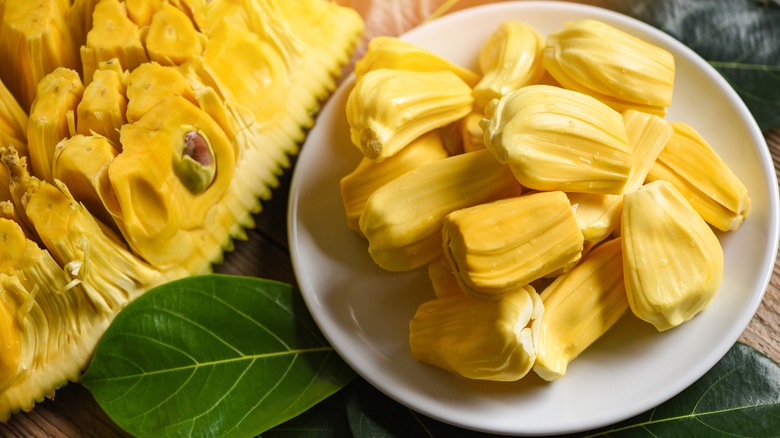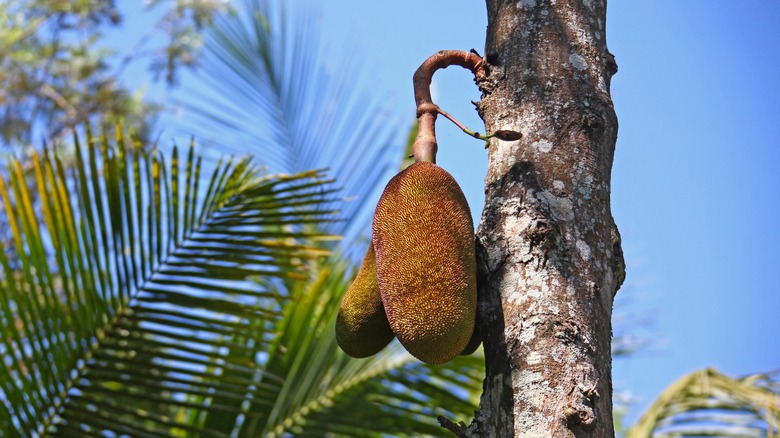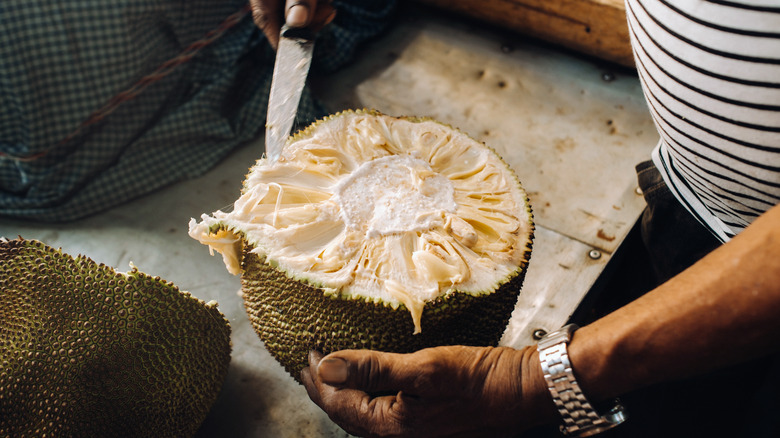Which Country Produces The Most Jackfruit?
Today, you can find jackfruits pre-cut, seasoned, conveniently packaged, and sold as plant-based alternatives in stores across the West — but have you ever seen a whole jackfruit? If you have, it may have come as a surprise. According to Jack and Agroforestry, a chapter from the book "The Jackfruit," jackfruits are the largest tree-grown fruits in the world. Weighing anywhere from 10 to 25 pounds, whole jackfruits are huge, green, round, and spikey — not necessarily what you imagine when biting into your vegan pulled pork sandwich.
Food Unfolded says that jackfruits are made of three parts: The skin, the internal bulbs, and the seeds. While the fruit's flesh is full of dietary fiber, the bulbs and seeds are packed with essential vitamins, nutrients, carbs, and protein (via World Atlas). The fruits are an everyday food in Southeast Asian diets, where both parts are fried, sauteed, minced, and used to make curries, juices, creams, and cakes. Ripe jackfruit bulbs have a tropical taste, often described as a mix between bananas and pineapples. However, jackfruits can also be harvested unripe — the stage at which the fruits deliver the meat-like texture they've been popularized for.
Where jackfruits grow
As crops, jackfruits are drought resistant and require very little maintenance. Their easy-going nature makes them a staple crop in both tropical and subtropical areas, where the trees and fruits serve multiple functions. From a source of nutrition and timber to livestock feed, an article from the Babu Banarasi Das National Institute of Technology & Management shows that jackfruit trees and fruits play important roles in local food systems while using very few resources. Even so, Food Unfolded claims that these trees are rarely grown in orchards.
According to the chapter, Jack and Agroforestry, from the book "The Jackfruit," jackfruit trees are more commonly found growing as roadside greenery in their native countries. Funnily enough, jackfruits have been growing in the backyards of coastal Indians and Southeast Asians for many years — and they've caused quite a nuisance. While the fruits can be grown anywhere from Florida to the Pacific Islands, they are so abundant across the south coast of India that tonnes of them used to go to waste every single year (via Phys). But that all changed when chefs from San Francisco to London began introducing the fruit as a new plant-based alternative.
When life gives you jackfruits, give them to the vegans
Phys explains that producers of jackfruit capitalized on this interest, and India specifically found a use for all of their extra fruits. With the demand for jackfruits equating to over 100 metric tonnes each day in Tamil Nadu and Kerala alone, India has become the largest producer of jackfruits in the world, providing 1.4 million tons of them (via World Atlas). In production, India is followed by Bangladesh, where jackfruit is considered the national fruit, Thailand, Indonesia, and Nepal.
So, next time you see a package of jackfruit-bulled pork at the store, you can almost bet that it was grown in India. The same can be said for any of the whole jackfruits you may come across, which are usually found in the spring and summer months (via Eat This Not That) — just don't be startled by their size, and if you do choose to purchase one, be sure to have a grocery cart on hand and watch this video on how to break down jack fruit like a pro.


